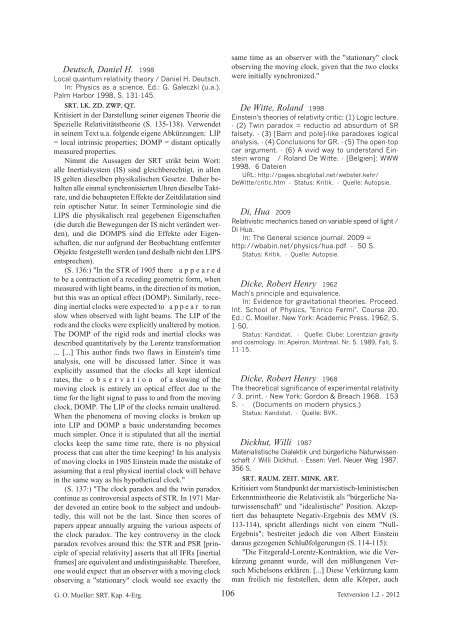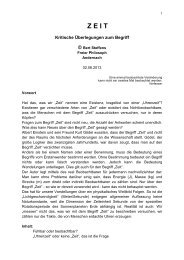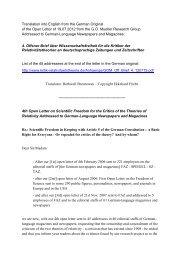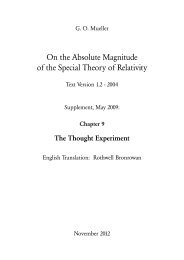2394 weitere kritische Veröffentlichungen - Kritische Stimmen zur ...
2394 weitere kritische Veröffentlichungen - Kritische Stimmen zur ...
2394 weitere kritische Veröffentlichungen - Kritische Stimmen zur ...
Sie wollen auch ein ePaper? Erhöhen Sie die Reichweite Ihrer Titel.
YUMPU macht aus Druck-PDFs automatisch weboptimierte ePaper, die Google liebt.
Deutsch, Daniel H. 1998<br />
Local quantum relativity theory / Daniel H. Deutsch.<br />
In: Physics as a science. Ed.: G. Galeczki (u.a.).<br />
Palm Harbor 1998, S. 131-145.<br />
SRT. LK. ZD. ZWP. QT.<br />
Kritisiert in der Darstellung seiner eigenen Theorie die<br />
Spezielle Relativitätstheorie (S. 135-138). Verwendet<br />
in seinem Text u.a. folgende eigene Abkürzungen: LIP<br />
= local intrinsic properties; DOMP = distant optically<br />
measured properties.<br />
Nimmt die Aussagen der SRT strikt beim Wort:<br />
alle Inertialsystem (IS) sind gleichberechtigt, in allen<br />
IS gelten dieselben physikalischen Gesetze. Daher behalten<br />
alle einmal synchronisierten Uhren dieselbe Taktrate,<br />
und die behaupteten Effekte der Zeitdilatation sind<br />
rein optischer Natur. In seiner Terminologie sind die<br />
LIPS die physikalisch real gegebenen Eigenschaften<br />
(die durch die Bewegungen der IS nicht verändert werden),<br />
und die DOMPS sind die Effekte oder Eigenschaften,<br />
die nur aufgrund der Beobachtung entfernter<br />
Objekte festgestellt werden (und deshalb nicht den LIPS<br />
entsprechen).<br />
(S. 136:) "In the STR of 1905 there a p p e a r e d<br />
to be a contraction of a receding geometric form, when<br />
measured with light beams, in the direction of its motion,<br />
but this was an optical effect (DOMP). Similarly, receding<br />
inertial clocks were expected to a p p e a r to run<br />
slow when observed with light beams. The LIP of the<br />
rods and the clocks were explicitly unaltered by motion.<br />
The DOMP of the rigid rods and inertial clocks was<br />
described quantitatively by the Lorentz transformation<br />
... [...] This author finds two flaws in Einstein's time<br />
analysis, one will be discussed latter. Since it was<br />
explicitly assumed that the clocks all kept identical<br />
rates, the o b s e r v a t i o n of a slowing of the<br />
moving clock is entirely an optical effect due to the<br />
time for the light signal to pass to and from the moving<br />
clock, DOMP. The LIP of the clocks remain unaltered.<br />
When the phenomena of moving clocks is broken up<br />
into LIP and DOMP a basic understanding becomes<br />
much simpler. Once it is stipulated that all the inertial<br />
clocks keep the same time rate, there is no physical<br />
process that can alter the time keeping! In his analysis<br />
of moving clocks in 1905 Einstein made the mistake of<br />
assuming that a real physical inertial clock will behave<br />
in the same way as his hypothetical clock."<br />
(S. 137:) "The clock paradox and the twin paradox<br />
continue as controversial aspects of STR. In 1971 Marder<br />
devoted an entire book to the subject and undoubtedly,<br />
this will not be the last. Since then scores of<br />
papers appear annually arguing the various aspects of<br />
the clock paradox. The key controversy in the clock<br />
paradox revolves around this: the STR and PSR [principle<br />
of special relativity] asserts that all IFRs [inertial<br />
frames] are equivalent and undistinguishable. Therefore,<br />
one would expect that an observer with a moving clock<br />
observing a "stationary" clock would see exactly the<br />
G. O. Mueller: SRT. Kap. 4-Erg.<br />
106<br />
same time as an observer with the "stationary" clock<br />
observing the moving clock, given that the two clocks<br />
were initially synchronized."<br />
De Witte, Roland 1998<br />
Einstein's theories of relativity critic: (1) Logic lecture.<br />
- (2) Twin paradox = reductio ad absurdum of SR<br />
falsety. - (3) [Barn and pole]-like paradoxes logical<br />
analysis. - (4) Conclusions for GR. - (5) The open-top<br />
car argument. - (6) A vivid way to understand Einstein<br />
wrong / Roland De Witte. - [Belgien]: WWW<br />
1998. 6 Dateien<br />
URL: http://pages.sbcglobal.net/webster.kehr/<br />
DeWitte/critic.htm - Status: Kritik. - Quelle: Autopsie.<br />
Di, Hua 2009<br />
Relativistic mechanics based on variable speed of light /<br />
Di Hua.<br />
In: The General science journal. 2009 =<br />
http://wbabin.net/physics/hua.pdf - 50 S.<br />
Status: Kritik. - Quelle: Autopsie.<br />
Dicke, Robert Henry 1962<br />
Mach's principle and equivalence.<br />
In: Evidence for gravitational theories. Proceed.<br />
Int. School of Physics, "Enrico Fermi". Course 20.<br />
Ed.: C. Moeller. New York: Academic Press. 1962, S.<br />
1-50.<br />
Status: Kandidat. - Quelle: Clube: Lorentzian gravity<br />
and cosmology. In: Apeiron. Montreal. Nr. 5. 1989, Fall, S.<br />
11-15.<br />
Dicke, Robert Henry 1968<br />
The theoretical significance of experimental relativity<br />
/ 3. print. - New York: Gordon & Breach 1968. 153<br />
S. - (Documents on modern physics.)<br />
Status: Kandidat. - Quelle: BVK.<br />
Dickhut, Willi 1987<br />
Materialistische Dialektik und bürgerliche Naturwissenschaft<br />
/ Willi Dickhut. - Essen: Verl. Neuer Weg 1987.<br />
356 S.<br />
SRT. RAUM. ZEIT. MINK. ART.<br />
Kritisiert vom Standpunkt der marxistisch-leninistischen<br />
Erkenntnistheorie die Relativistik als "bürgerliche Naturwissenschaft"<br />
und "idealistische" Position. Akzeptiert<br />
das behauptete Negativ-Ergebnis des MMV (S.<br />
113-114), spricht allerdings nicht von einem "Null-<br />
Ergebnis"; bestreitet jedoch die von Albert Einstein<br />
daraus gezogenen Schlußfolgerungen (S. 114-115):<br />
"Die Fitzgerald-Lorentz-Kontraktion, wie die Verkürzung<br />
genannt wurde, will den mißlungenen Versuch<br />
Michelsons erklären. [...] Diese Verkürzung kann<br />
man freilich nie feststellen, denn alle Körper, auch<br />
Textversion 1.2 - 2012





